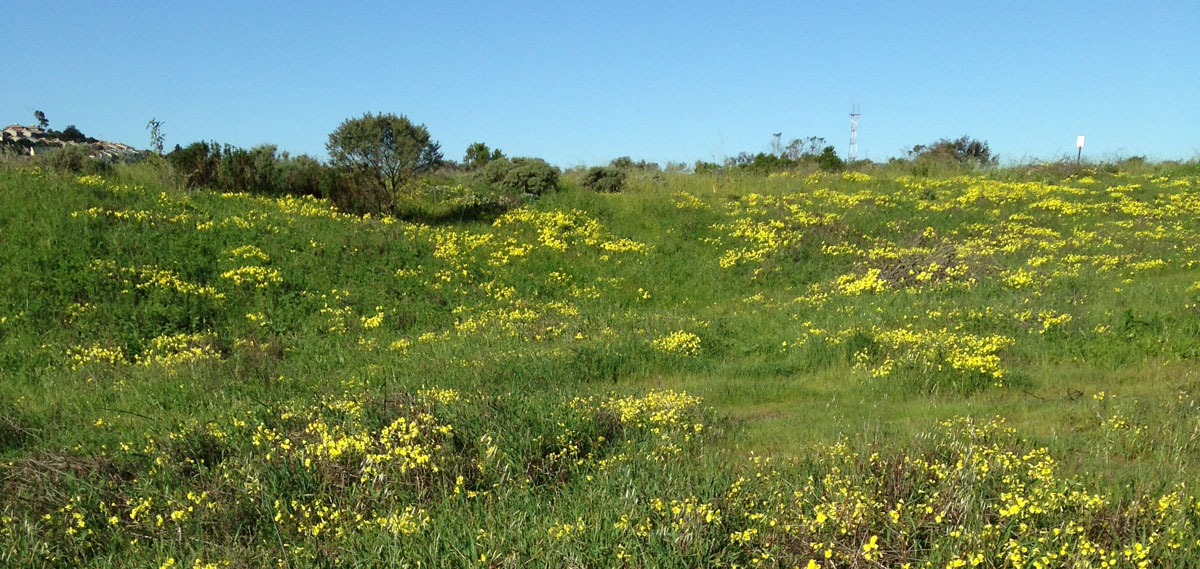Oxalis pes-caprae is an attractive little flower with five yellow petals and leaves that are cloven in a way that apparently reminded Linnaeus—who described the species in 1753—of a goat’s foot. Commonly known as sourgrass or Bermuda buttercup, it flowers from November to April, and in the last few months oxalis has come out in full force in the Bay Area, encouraged by December and February rains. The flowers dot hillsides, parks, and highway medians like the mottled points of light in a Monet, delighting many observers.
They do not delight Jake Sigg.
“I’ve just been frantic about it,” says Sigg, a retired Golden Gate Park gardener and the Bay’s most outspoken opponent of yellow oxalis. “It’s our most troublesome plant.”
Oxalis pes-caprae is invasive, a weed native to South Africa that was transplanted to California early in the 1900s, probably to be grown as a demure ornamental plant. By the late 1980s, the Los Angeles Times reported in 1988, it was a frustratingly persistent nuisance in home gardens. Now, Sigg has watched in horror as oxalis has taken over the coastal grasslands he tends. He first noticed a small patch of them in San Francisco’s Grandview Park back in the 1980s. By 2003, Sigg says, it was all over the hill. “In the last 10 years it really got going fast,” he says. “It’s just a blitzkrieg.” And the onslaught will probably continue. “If we did nothing, in X many years Twin Peaks would just be one solid mass of yellow, and there wouldn’t be any other plants there,” Sigg says. “It’s destroying our grasslands.”
Oxalis crowds out native wildflowers for light and space, and prevents other plants from gaining a foothold in the land. “Oxalis is terminal,” Sigg says. Once it takes over, the wildlife that depends on native flowers moves on, leaving nothing but oxalis in its wake (and bare ground during the six months of the year oxalis doesn’t flower). An oxalis-dominated landscape drives away coyotes, hawks and owls that feed on grassland foragers, and the situation is especially dire for endangered Mission blue butterflies, which depend heavily on native wildflowers. Whole hillsides are now “marching towards monoculture,” Sigg says. But we haven’t raised the alarm because, as he wrote in 2003, “we hardly notice [the spread] because it occurs slowly, subtly, surreptitiously.”

It could be worse, though, says Doug Johnson, executive director of the California Invasive Plant Council. Oxalis’s M.O. is simply to grow prolifically and crowd out other plants. It’s not dangerous from an economic standpoint; it’s not a fire hazard, and it doesn’t threaten crucial resources like crop plants. Eaten in large quantities, oxalis can poison sheep and other livestock, but the animals are usually put off by the sour oxalic acid in its leaves (also found in rhubarb and raw beets) before they overindulge. There’s also the simple fact that there’s just too much of the plant to tackle. “It’s not a target for landscape-level eradication because it’s way too widespread,” Johnson says.
What’s the secret to oxalis’s success? Like many other weeds, it’s hardy and aggressive, and thrives in areas of human disturbance. Oddly, oxalis doesn’t produce seeds in any of its invasive strongholds (which, besides California, include Arizona, Florida, southern Australia, and much of the western Mediterranean basin). Instead, it sends out lateral runners underground, and grows a taproot lined with small bulbs. Even if a flower is pulled, the bulblets remain in the ground for the next year, waiting to spawn anew and in greater numbers. Their spread is abetted by pocket gophers and scrub jays, which have been spotted carrying the bulbs and caching them in the ground—effectively planting them in new areas.
So is there any way to check the spread of these flowery legions?
Well, we can’t eat it out of existence. Oxalis is entirely edible, urban foragers note. But there’s much more growing than anyone would ever want to eat. Its extremely tart flavor makes it better as a zest or a garnish than a main dish, says Kevin Feinstein, coauthor of The Bay Area Forager (which includes a recipe for a sourgrass salad). “A little bit goes a long way,” Feinstein says, “and right now, there’s enough growing for everyone in the Bay Area.”
Oxalis is so widespread that physically removing the plant is no longer feasible. “It takes a surprising amount of resources to truly eradicate a population of weeds,” Johnson says. In oxalis’s case, the benefits that would accrue from fighting it on all fronts aren’t quite enough to justify the costs—there’s just not enough time or people to dedicate to the effort. (Not to mention that eliminating oxalis takes a doggedness that even Sigg describes as “fanatic.” He managed to eradicate it from his garden, but it took him five to six years, and he sometimes had to comb through his plants by hand.) Instead, Cal-IPC focuses its efforts on the battles that can be won: new, potentially dangerous weeds that can be stopped, or existing weeds that threaten valuable resources.
Our only hope is biological controls, or insects or other parasites that naturally attack oxalis into the wild. Sigg and Cal-IPC are beginning a push to request funding from the USDA for research into oxalis biocontrols. If the funds are approved, the research effort would involve traveling to South Africa to collect potential pests and bringing them back to a USDA quarantine lab in Albany, where they’d be tested in isolation to see if they can be released into the wild without going after California’s native oxalis species, including the redwood sorrel. “But that’s a decade-long effort, and whether that would be a high priority for the USDA group that develops biocontrols is an open question,” Johnson says.
So for now—and probably for good—oxalis is here to stay. And there’s not much we can do but admire the sheer tenacity of this perky, ubiquitous plant, and watch the yellow expanses grow year after year, slowly but surely.






